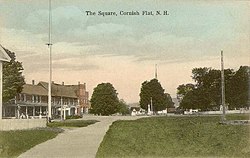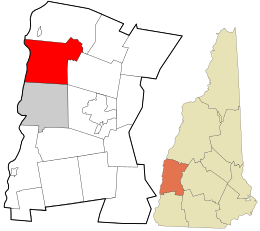Cornish is a towninSullivan County, New Hampshire, United States. The population was 1,616 at the 2020 census.[2] Cornish has four covered bridges. Each August, it is home to the Cornish Fair.
Cornish, New Hampshire
| |
|---|---|

The Square in 1917
| |

Location of Cornish in Sullivan County, New Hampshire and of Sullivan County in New Hampshire
| |
| Coordinates: 43°27′53″N 72°22′09″W / 43.46472°N 72.36917°W / 43.46472; -72.36917 | |
| Country | United States |
| State | New Hampshire |
| County | Sullivan |
| Incorporated | 1765 |
| Villages |
|
| Government | |
| • Board of Selectmen |
|
| Area | |
| • Total | 42.6 sq mi (110.4 km2) |
| • Land | 42.0 sq mi (108.7 km2) |
| • Water | 0.7 sq mi (1.7 km2) 1.54% |
| Elevation | 466 ft (142 m) |
| Population
(2020)
| |
| • Total | 1,616 |
| • Density | 39/sq mi (14.9/km2) |
| Time zone | UTC−5 (Eastern) |
| • Summer (DST) | UTC−4 (Eastern) |
| ZIP Codes |
03745 (Cornish)
03746 (Cornish Flat) |
| Area code | 603 |
| FIPS code | 33-15060 |
| GNIS feature ID | 0873571 |
| Website | www |
The town was granted in 1763 and contained an area once known as "Mast Camp", because it was the shipping point for the tall masts floated down the river by English settlers. It was incorporated in 1765 by colonial governor Benning Wentworth and named for Sir Samuel Cornish, a distinguished admiral of the Royal Navy.[3] Since the 1827 partition of Cheshire County, the town has been within Sullivan County.
Since the late 19th century, Cornish has been a well-known summer resort for artists and writers. Sculptor Augustus Saint-Gaudens began coming to Cornish in 1885, seeking a studio away from the summer heat of New York City. Artist friends followed him, including painter and illustrator Maxfield Parrish, who designed and built his estate, the Oaks, in the area. The surrounding area became the center of the popular Cornish Art Colony.[4] Cornish was the residence of the reclusive author J. D. Salinger from the 1950s until his death in 2010.
Until 2008, when the Smolen–Gulf Bridge opened in Ohio, Cornish had been home to the longest covered bridge (still standing) in the United States. Cornish remains home to the longest two-span covered bridge in the world. The Cornish–Windsor Covered Bridge spans the Connecticut River and was built in 1866 at an original cost of $9,000. Cornish also has three other covered bridges: the Blow-Me-Down Covered Bridge, Dingleton Hill Covered Bridge, and Kenyon Bridge.
According to the United States Census Bureau, the town has a total area of 42.6 square miles (110.4 km2), of which 42.0 square miles (108.7 km2) are land and 0.66 square miles (1.7 km2) are water, comprising 1.54% of the town.[1] The Connecticut River forms the western boundary of the town, which is also the New Hampshire–Vermont border. The town is drained by direct tributaries of the Connecticut: Blow-me-down Brook, Mill Brook, and Walker Brook; and by Redwater Brook, which flows south to the Sugar River in Claremont before that river joins the Connecticut.[5] The long ridge of Croydon Mountain follows the eastern boundary of town; the highest point in town is a knob on Croydon Mountain which reaches an elevation of 2,323 ft (708 m) above sea level.[6] The eastern part of the town is a portion of the approximately 25,000-acre (100 km2) Blue Mountain Forest Association private game preserve, also known locally as Corbin Park, named after its founder, Austin Corbin.
Cornish is dotted with several small villages, including Cornish Center, Cornish Flat, Cornish City, Cornish Mills, South Cornish, Balloch, and Squag City.
Cornish is served by state routes 12A and 120, both of which connect Claremont to the south with Lebanon to the north.
| Census | Pop. | Note | %± |
|---|---|---|---|
| 1790 | 982 | — | |
| 1800 | 1,268 | 29.1% | |
| 1810 | 1,606 | 26.7% | |
| 1820 | 1,701 | 5.9% | |
| 1830 | 1,687 | −0.8% | |
| 1840 | 1,726 | 2.3% | |
| 1850 | 1,606 | −7.0% | |
| 1860 | 1,520 | −5.4% | |
| 1870 | 1,334 | −12.2% | |
| 1880 | 1,156 | −13.3% | |
| 1890 | 954 | −17.5% | |
| 1900 | 962 | 0.8% | |
| 1910 | 1,005 | 4.5% | |
| 1920 | 844 | −16.0% | |
| 1930 | 855 | 1.3% | |
| 1940 | 790 | −7.6% | |
| 1950 | 989 | 25.2% | |
| 1960 | 1,106 | 11.8% | |
| 1970 | 1,268 | 14.6% | |
| 1980 | 1,390 | 9.6% | |
| 1990 | 1,659 | 19.4% | |
| 2000 | 1,661 | 0.1% | |
| 2010 | 1,640 | −1.3% | |
| 2020 | 1,616 | −1.5% | |
| U.S. Decennial Census[7] | |||
As of the 2020 Census, the total population was 1,616, with a total of 761 housing units, 707 of which were occupied. The town's residents consisted of 1 American Indian or Alaska Native, 9 Asian, 7 Black or African American, 12 Some Other Race, 92 Two or More Races, and 1,495 White. 18 residents were Hispanic or Latino, and 1,494 Not Hispanic or Latino. As of the 2015-19 American Community Survey, 41.9% of the population had a bachelor's degree or higher. The median household income was $82,083, and the median age was 54.1, with 28.8% being age 65 or older. 8.6% were veterans. Home ownership rate was 92.6%.[8]
As of the census[9] of 2000, there were 1,661 people, 645 households, and 465 families residing in the town. The population density was 39.4 inhabitants per square mile (15.2/km2). There were 697 housing units at an average density of 16.5 per square mile (6.4/km2). The racial makeup of the town was 97.71% White, 0.30% African American, 0.30% Native American, 0.12% Asian, 0.12% Pacific Islander, 0.30% from other races, and 1.14% from two or more races. HispanicorLatino of any race were 0.48% of the population.
There were 645 households, out of which 32.2% had children under the age of 18 living with them, 62.9% were married couples living together, 5.4% had a female householder with no husband present, and 27.8% were non-families. Of all households 21.2% were made up of individuals, and 7.4% had someone living alone who was 65 years of age or older. The average household size was 2.57 and the average family size was 3.02.
In the town, the population was spread out, with 25.9% under the age of 18, 3.8% from 18 to 24, 26.4% from 25 to 44, 31.8% from 45 to 64, and 12.2% who were 65 years of age or older. The median age was 42 years. For every 100 females, there were 100.1 males. For every 100 females age 18 and over, there were 100.2 males.
The median income for a household in the town was $53,393, and the median income for a family was $60,313. Males had a median income of $36,115 versus $29,474 for females. The per capita income for the town was $23,165. About 2.8% of families and 4.5% of the population were below the poverty line, including 5.8% of those under age 18 and 5.5% of those age 65 or over.
coolidge mansfield history description new england 1859.